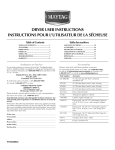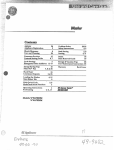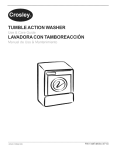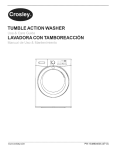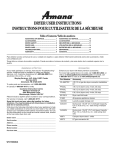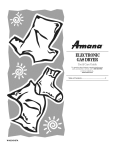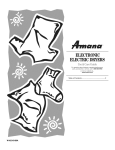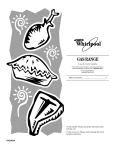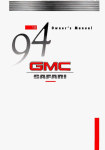Download Whirlpool 8578179 Use & care guide
Transcript
WASHER/DRYER USERINSTRUCTIONS Tableof Contents ASSISTANCE OR SERVICE ............................. WASHER/DRYER SAFETY .............................. 1 1 WASHER USE ................................................... 3 DRYER USE ...................................................... 5 WASHER/DRYER 6 CARE .................................. WASHER TROUBLESHOOTING DRYER TROUBLESHOOTING WARRANTY ..................... 8 ...................... 10 .................................................... 12 Assistance or Service If you need assistance or service, first see the "Troubleshooting" section. Additional help is available by calling our Customer Interaction Center at 1-800-253-1301 from anywhere in the U.S.A., or write: Whirlpool Corporation Customer Interaction Center 553 Benson Road Benton Harbor, MI 49022-2692 Please include a daytime phone number in your correspondence. Write down the following information about your appliance to help you obtain assistance or service if you ever need it. You will need to know your complete model number and serial number. You can find this information on the model and serial number label, located at the top inside dryer door well. To order parts and accessories, call 1-800-442-9991 or visit our website at www.whirlpool.com. Keep this book and your sales slip together for future reference. You must provide proof of purchase or installation date for in-warranty service. Phone number Dealer name Serial number Address Model number Purchase date WASHER/DRYER SAFETY Your safety and the safety of others are very important. We have provided many important safety messages in this manual and on your appliance. Always read and obey all safety messages. This is the safety alert symbol. This symbol alerts you to potential hazards that can kill or hurt you and others. All safety messages will follow the safety alert symbol and either the word "DANGER" or "WARNING." These words mean: You can be killed or seriously injured if you don't immediately follow instructions. You can be killed or seriously injured if you don't follow instructions. All safety messages will tell you what the potential hazard is, tell you how to reduce the chance of injury, and tell you what can happen if the instructions are not followed. 8578179 WARNING: For your safety, the information in this manual must be followed to minimize the risk of fire or explosion, or to prevent property damage, personal injury, or death. - Do not store or use gasoline or other flammable or any other appliance. - WHAT TO DO IF YOU SMELL vapors and liquids in the vicinity of this GAS: • Do not try to light any appliance. • Do not touch any electrical switch; do not use any phone in your building. • Clear the room, building, or area of all occupants. • Immediately call your gas supplier from a neighbor's phone. Follow the gas supplier's instructions. • If you cannot reach your gas supplier, call the fire department. - Installation and service must be performed by a qualified installer, service agency, or the gas supplier. IMPORTANT SAFETY INSTRUCTIONS WARNING:To reduce the risk of fire, electric shock, or injury to persons when using the washer/dryer, basic precautions, including the following: [] Read all instructions before using the washer/dryer. [] Do not place items exposed to cooking oils in your dryer. Items contaminated with cooking oils may contribute to a chemical reaction that could cause a load to catch fire. [] Do not wash or dry articles that have been previously cleaned in, washed in, soaked in, or spotted with gasoline, dry-cleaning solvents, other flammable, or explosive substances as they give off vapors that could ignite or explode. [] Do not add gasoline, dry-cleaning solvents, or other flammable, or explosive substances to the wash water. These substances give off vapors that could ignite or explode. [] Do not allow children to play on or in the washer/dryer. Close supervision of children is necessary when the washer/dryer is used near children. [] Before the washer/dryer is removed from service or discarded, remove the doors to the washer/dryer compartments. [] Do not reach into the washer/dryer if the tub, agitator or drum is moving. [] Do not install or store the washer/dryer where it will be exposed to the weather. [] Do not tamper with controls. [] Clean dryer lint screen before or after each load. follow [] Under certain conditions, hydrogen gas may be produced in a hot water system that has not been used for 2 weeks or more. HYDROGEN GAS IS EXPLOSIVE. If the hot water system has not been used for such a period, before using the washing machine, turn on all hot water faucets and let the water flow from each for several minutes. This will release any accumulated hydrogen gas. As the gas is flammable, do not smoke or use an open flame during this time. [] Do not repair or replace any part of the washer/dryer or attempt any servicing unless specifically recommended in this Use and Care Guide or in published user-repair instructions that you understand and have the skills to carry out. [] Do not use fabric softeners or products to eliminate static unless recommended by the manufacturer of the fabric softener or product. [] Do not use heat to dry articles containing foam rubber or similarly textured rubber-like materials. [] Keep area around the exhaust opening and adjacent surrounding areas free from the accumulation of lint, dust, and dirt. [] The interior of the machine and dryer exhaust vent should be cleaned periodically by qualified service personnel. [] See "Electrical Requirements" instructions. SAVETHESEINSTRUCTIONS section for grounding Your dryer must be properly installed and vented to achieve maximum drying efficiency and shorten drying times. Use the minimum recommended installation clearances (found in your Installation Instructions) to avoid blocking the flow of combustion and ventilation air. See the Installation Instructions for more information. NOTE: Service calls caused by improper venting will be paid for by the customer, whether it was a paid installation or selfinstalled. f. 2. 3. Do not use plastic vent or metal foil vent. Use 4 in. (10.2 cm) metal or flexible metal vent. Do not kink or crush flexible metal vent. It must be completely extended to allow adequate exhaust air to flow. Check vent after installation. Refer to your Installation Instructions for proper length requirements of vent. Use a 4 in. (10.2 cm) exhaust hood. Use the straightest path possible when routing the vent. Fire Hazard Use a heavy metal vent. Do not use a plastic vent. 4. Use clamps to seal all joints. Do not use duct tape, screws or other fastening devices that extend into the interior of the vent to secure vent. 5. Clean exhaust vent periodically, depending on use, but at least every 2 years, or when installing your dryer in a new location. When cleaning is complete, be sure to follow the Installation Instructions supplied with your dryer for final product check. Do not use a metal foil vent. Failure to fellow or fire. these instructions can result in death If the dryer is not properly installed and vented, it will not be covered under the warranty. WASHERUSE For these suggested full-sized loads, set the LOAD SIZE selector to the highest load size setting. LARGE CAPACITY WASHERS Heavy Work Clothes 2 pair of pants 3 shirts 3 jeans 1 coverall Mixed Load 2 double sheets 4 pillowcases 6 T-shirts 6 pair of shorts 2 shirts 2 blouses 6 handkerchiefs Towels 8 bath towels 8 hand towels 10 washcloths 1 bath mat COMPACT Heavy Work Clothes 2 pair of pants 3 shirts Mixed Load 1 pair of pants 2 pillowcases 2 shirts 1 T-shirt Towels 9 bath towels -or6 bath towels 3 hand towels 6 washcloths Delicates 2 camisoles 4 slips 6 undergarments 2 sets of sleepwear 1 child's outfit Permanent Press 1 double sheet 1 tablecloth 1 dress 1 blouse 2 pair of pants 3 shirts 2 pillowcases Knits 2 pair of pants 2 blouses 4 shirts 4 tops 2 dresses Permanent Press 6 shirts -or2 double sheets 2 pillowcases Knits 2 pair of pants 2 shirts -or3 dresses WASHERS Delicates 1 camisole 2 slips 4 undergarments 1 set of sleepwear 1 half slip -or- single sheets 2 pillowcases 2 Fire Hazard Electrical Shock Hazard Never place items in the washer that are dampened with gasoline or other flammable fluids. Plug into a grounded No washer Do not use an adapter. can completely remove 3 prong outlet. Do not remove ground oil. prong. Do not dry anything that has ever had any type of oil on it (including cooking oils). Do not use an extension cord. Doing so can result in death, explosion, or fire. Failure to follow these instructions can result in death, fire, or electrical shock. Measure detergent and pour it into the washer. If desired, add powdered or liquid color safe bleach. Drop a sorted load of clothes loosely into your washer. • 2= Load evenly to maintain washer balance. Mix large and small items. Items should move easily through the wash water. Overloading can cause poor cleaning. (OPTIONAL) Add Liquid Chlorine Bleach. Always measure liquid chlorine bleach. Do not guess. Never use more than 1 cup (250 mL) for a full load. Follow manufacturer's directions for safe use. Use a cup with a pouring spout to avoid spilling. Let the washer fill and begin agitating the load. Add bleach to the wash cycle so it can be removed in the rinse cycle. Pour bleach around the agitator, not directly onto the load. • Follow directions on the care labels. Do not use chlorine bleach on wool, silk, spandex, acetates, or some flameretardant fabrics. NOTE: Undiluted bleach will damage any fabric it touches. The damage appears as rips, holes, tears, or color loss and may not show up until several washings later. 3= Style 2: Without Liquid Fabric Softener Dispenser (on some models) • 4= 5. 6. (OPTIONAL) Add Liquid Fabric Softener. NOTE: Your washer/dryer does not come with a fabric softener dispenser installed. To find out whether your model allows fabric softener dispenser usage and for ordering information, refer to the front page of your manual or call the dealer from whom you purchased your washer/dryer. Ask for Part Number 3350834. NOTE: Do not spill or drip any fabric softener onto the clothes. Undiluted fabric softener can stain fabrics. Always dilute fabric softener with warm water. Too much fabric softener can make some items (diapers and towels) nonabsorbent. If this happens, do not use it in every load, or use less of it in each load. Style 1: With Liquid Fabric Softener Dispenser (on some models) • Use only liquid fabric softener in this dispenser. Pour measured liquid fabric softener into the dispenser. Softener is added automatically during the rinse portion of the cycle. Dilute liquid fabric softener by filling the dispenser with warm water until liquid reaches the crossbar in the dispenser opening. 7. In the final rinse ONLY, add fabric softener that has been diluted with 1/2to 1 cup (125 to 250 mL) warm water. Close the washer lid. Washer will not agitate or spin with the lid open. Turn the LOAD SIZE selector to the correct setting for your wash load and the type of fabric being washed. You may change the load size or water level selection after the washer has started filling by turning the selector to a different setting. Set the TEMPERATURE selector to the correct setting for the type of fabric and soils being washed. Use the warmest water safe for fabric. Follow garment label instructions. NOTE: In wash water temperatures colder than 70°F (21°C), detergents do not dissolve well. Soils can be difficult to remove. Some fabrics can retain wear wrinkles and have increased pilling (the formation of small lint-like balls on the surface of garments). Push in the Cycle Control knob and turn it clockwise to the wash cycle you want. Reduce the wash time when using a small load size setting. Pull out the Cycle Control knob to start the washer. To stop or restart your washer: • To stop the washer at any time, push in the Cycle Control knob. • To restart the washer, close the lid (if open) and pull out the Cycle Control knob. DRYERUSE Load clothes loosely into the dryer. Do not pack the dryer. Allow space for clothes to tumble freely. The following charts show examples of balanced loads that would allow for proper tumbling. LARGE CAPACITY DRYER Heavy Work Clothes 2 pair of pants 3 pair of jeans 1 coverall 3 shirts Mixed Load 2 double sheets 4 pillowcases 6 T-shirts 6 pair of shorts 2 blouses 6 handkerchiefs 2 shirts Towels 8 bath towels 8 hand towels 10 washcloths 1 bath mat Delicates 2 camisoles 4 slips 6 undergarments 2 sets of sleepwear 1 child's outfit COMPACT Heavy Work Clothes 2 pair of pants 3 shirts Mixed Load 1 pair of pants 2 pillowcases 1 T-shirt 2 shirts Towels 9 bath towels -or6 bath towels 3 hand towels 6 washcloths Knits 2 pair of pants 2 blouses 4 shirts 4 tops 2 dresses Permanent Press 6 shirts -or2 double sheets 2 pillowcases -or2 single sheets 2 pillowcases Knits 2 pair of pants 2 shirts -or3 dresses DRYER Delicates 1 camisole 2 slips 7 undergarments 1 set of sleepwear Fire Hazard Explosion Hazard Keep flammable materials and vapors, such as gasoline, away from dryer. No washer can completely remove oil. Do not dry anything that has ever had any type of oil on it (including cooking oils). Do not dry anything that has ever had anything flammable on it (even after washing). Failure to follow these instructions explosion, or fire. Permanent Press 1 double sheet 1 tablecloth 1 dress 1 blouse 2 pair of pants 3 shirts 2 pillowcases Items containing foam, rubber, or plastic must be dried on a clothesline or by using an Air Cycle. can result in death, Failure to follow these instructions or fire. can result in death This booklet covers several different models. Your dryer may not have all of the cycles and features described. Before using your dryer, wipe the dryer drum with a damp cloth to remove dust from storing and shipping. 4. 1. Stopping and Restarting You can stop your dryer anytime during a cycle. 2. 3. Load clothes loosely into the dryer and close the door. Do not pack the dryer. Allow space for clothes to tumble freely. Turn the Cycle Control knob to the recommended cycle for the type of load being dried. Use the Energy Preferred Automatic Setting to dry most heavy to medium weight fabrics. (OPTIONAL) Your dryer may have an END OF CYCLE SIGNAL. The signal is helpful when drying items that should be removed from the dryer as soon as it stops. The End of Cycle signal is part of the Start button and is selectable. Turn the Start button to ON or OFR The signal will sound only if the selector is set to On. 5. If desired, add fabric softener sheet. Use only ones labeled as dryer safe. Follow package instructions. Press the PUSH TO START button. To stop your dryer Open the dryer door or turn the Cycle Control knob to OFF. NOTE: The Cycle Control knob should point to an Off area when the dryer is not in use. To restart your dryer Close the door. Select a new cycle and temperature (if desired). Press the PUSH TO START button. WASHER/DRYER CARE Use a soft, damp cloth or sponge to wipe up any spills such as detergent or bleach from the outside of your washer. Clean your washer interior by mixing 1 cup (250 mL) of chlorine bleach and 2 cups (500 mL) of detergent. Pour this mixture into your washer and run it through a complete cycle using hot water. Repeat this process if necessary. Remove any hard water deposits using only cleaners labeled as washer safe. Cleaning the liquid fabric softener dispenser (on some models): 1. Remove dispenser by grasping top with both hands and squeezing, while pushing upward with thumbs. 2. Rinse dispenser under a warm water faucet, then replace it. NOTE: If your model has a liquid fabric softener dispenser, do not wash clothes with this dispenser removed. Do not add detergent or bleach to this dispenser; it is for liquid fabric softener only. Clean the lint screen before each load. A screen blocked by lint can increase drying time. IMPORTANT: • Do not run the dryer with the lint screen loose, damaged, blocked, or missing. Doing so can cause overheating and damage to both the dryer and fabrics. • If lint falls off the screen into the dryer during removal, check the exhaust hood and remove the lint. Every Load Cleaning Style 1: 1. The lint screen is located inside the dryer on the back wall. Pull out the lint screen and its cover. 2. 3. Replace inlet hoses after 5 years of use to reduce the risk of hose failure. Periodically inspect and replace inlet hoses if bulges, kinks, cuts, wear or leaks are found. When replacing your inlet hoses, mark the date of replacement on the label with a permanent marker. 4. Put the lint screen and cover back together and push firmly back into place. Style 2: 1. The lint screen is located inside the dryer in the front door well. Pull the lint screen straight up. Roll lint off the screen with your fingers. Do not rinse or wash screen to remove lint. Wet lint is hard to remove. 2. Keep dryer area clear and free from items that would obstruct the flow of combustion and ventilation air. 1. 2. Roll lint off the screen with your fingers. Wet both sides of lint screen with hot water. 3. Wet a nylon brush with hot water and liquid detergent. Scrub lint screen with the brush to remove residue buildup. Rinse screen with hot water. 5. Keep flammable materials and vapors, such as gasoline, away from dryer. Place dryer at least 18 inches (46 cm) above the floor for a garage installation. Failure to do so can result in death, explosion, or fire. Push the lint screen firmly back into place. As Needed Cleaning 4. Explosion Hazard Separate the cover and the screen by squeezing the screen and pulling on the cover at the same time. Roll lint off the screen with your fingers. Do not rinse or wash screen to remove lint. Wet lint is hard to remove. Thoroughly dry lint screen with a clean towel. Replace screen in dryer. Non-use or vacation care 1. Applya non-flammable household cleaner tothestained area ofthedrumandrubwithasoftclothuntilstainisremoved. 2. Wipedrumthoroughly witha dampcloth. 3. Tumble a loadofcleanclothsortowels todrythedrum. NOTE: Garments whichcontain unstable dyes,suchasdenim bluejeansorbrightly colored cottonitems,maydiscolor thedryer interior. These stainsarenotharmful toyourdryerandwillnot stainfutureloadsofclothes. Dryunstable dyeitemsinside-out to prevent dyetransfer. Operate your washer/dryer only when you are at home. If you will be on vacation or not using your washer/dryer for an extended period of time, you should: • Unplug washer/dryer or disconnect power. • To transport the washer/dryer 1. Shut off both water faucets. Disconnect and drain water inlet hoses. Place the inlet hoses in the basket. 2. If washer/dryer will be moved during freezing weather, put in a qt (1 L) of R.V.-type antifreeze in the basket. Run washer on a spin setting for about 30 seconds to mix the antifreeze and water. 3. 4. 5. Disconnect the drain from the drain system. Unplug washer/dryer or disconnect power. Disconnect the exhaust vent. 6. If your washer/dryer is a gas model, close shutoff valve in gas supply line, disconnect gas supply line pipe and remove fittings attached to the washer/dryer pipe. Wash lint screen. From Inside the Dryer Cabinet Lint should be removed every 2 years, or more often, depending on dryer usage. Cleaning should be done by a qualified person. From Inside the Exhaust Vent Lint should be removed every 2 years, or more often, depending on dryer usage. 7. Install and store your washer/dryer where it will not freeze. Because some water may stay in the hoses, freezing can damage your washer/dryer. If storing or moving your washer/dryer during freezing weather, winterize it. 8. Drape the power cord and drain hose over edge and into the basket. 9. Make sure leveling legs are secure. Use masking tape to secure the washer lid and dryer door. Reinstalling your washer/dryer To winterize washer/dryer 1. Shut off both water faucets. Disconnect and drain water inlet hoses. Put 1 qt (1 L) of R.V.-type antifreeze in the basket. 2. Run washer on a drain and spin setting for about 30 seconds to mix the antifreeze and water. 3. Unplug washer/dryer or disconnect power. To use washer/dryer again 1. Flush water pipes and hoses. Reconnect water inlet hoses. Turn on both water faucets. 2. 3. Plug in washer/dryer or reconnect power. Run the washer through a complete cycle with 1 cup (250 mL) of detergent to clean out antifreeze. Turn off the water supply to the washer. This helps avoid accidental flooding (due to a water pressure surge) while you are away. 1. 2. Follow the "Installation Instructions" to locate, level, and connect the washer/dryer. Run the washer through the Normal cycle with 1 scoop or cap full of detergent to clean the washer and remove the antifreeze, if used. WASHERTROUBLESHOOTING First try the solutions suggested here and possibly avoid the cost of a service call... Noisy • • • Washer stops, won't fill, rinse or agitate Is the load balanced and the washer/dryer level? The wash load should be balanced and not overloaded. The washer/ dryer must be level. The front feet should be properly installed and the nuts tightened. Reset the rear leveling legs (if needed). See the Installation Instructions. • Is the power cord plugged into a grounded 3 prong outlet? Is the indicator on the Cycle Control knob properly lined up with a cycle? Turn the Cycle Control knob to the right slightly and pull to start. Did you completely remove the yellow shipping strap with cotter pins? See the Installation Instructions. Are the water inlet valve screens clogged? Are both the hot and cold water faucets turned on? Are the gears engaging after the drain and before spin, or is the upper part of agitator clicking during wash? These are normal washer noises. is the water inlet hose kinked? Check the following: Does the water level seem too low, or does the washer appear to not fill completely? The top of the agitator is much higher than the highest water level. This is normal and necessary for clothes to move freely. Are the fill hoses tight? Is there power at the plug? Check your electrical source or call an electrician. Leaking • Are the fill hose washers properly seated? Has a fuse blown or is the circuit continues, call an electrician. Is the drain hose clamp properly installed? See the Installation Instructions. • Is the sink or drain clogged? Sink and standpipe must be able to handle 17 gal. (64 L) of water per minute. • Is water deflecting off the tub ring or the load? Center the tub before starting the washer. The wash load should be balanced and not overloaded. The fill or spray rinses can deflect off the load. The washer/dryer must be level. Ensure that the leveling legs are properly installed. See the Installation Instructions. • Check household plumbing Are you using an extension cord. Is the lid open? The lid must be closed during operation. Washer will not agitate or spin with the lid open. Washer won't drain or spin • Was the washer basket pulled forward during loading? Push the basket to the center before starting wash. • Is the load balanced and the washer/dryer level? The wash load should be balanced and not overloaded. The washer/ dryer must be level. Ensure that the leveling legs are properly installed. See the Installation Instructions. • The washer • Is the drain hose clogged, or the end of the drain hose more than 96 in. (244 cm) above the floor? See the Installation Instructions for proper installation of drain hose. • is the lid open? The lid must be closed during operation. Washer will not agitate or spin with the lid open. • Is there excessive sudsing? Always measure detergent. Follow manufacturer's directions. If you have very soft water, you may need to use less detergent. • Is your voltage low? Check your electrical source or call an electrician. Do not use an extension cord. This is normal. Agitator operation The top of the agitator is loose, or moves in only one direction. This is normal. Dispenser clogged (on some models) • cord? Do not use an extension Is the washer overloaded? Wash smaller loads. for leaks. basket moves while washing. breaker open? If problem Is the washer in a normal pause in the cycle? The washer pauses for about 2 minutes during certain cycles. Allow the cycle to continue. Some cycles feature periods of agitation and soak. Basket crooked • Check the following: Did you follow the manufacturer's directions when adding fabric softener to the dispenser (on some models)? Measure fabric softener and carefully pour into the dispenser. Wipe up all spills. Dilute fabric softener in the fabric softener dispenser. Washer continues to fill or drain, cycle seems stuck • Is the top of drain hose lower than the water level in washer? The top of the hose must be higher than the water level in the washer for proper operation. See the Installation Instructions. Does the drain hose fit too tightly in the standpipe, or is it taped to the standpipe? The drain hose should be loose yet fit securely. Do not seal the drain hose with tape. The hose needs an air gap. See the Installation Instructions. Load is wrinkled Wash temperature not what I selected • Are the hot and cold water inlet hoses reversed? See the Installation Instructions for more information. As your frequency of loads washed increases, the water temperature may decrease for hot and warm temperature selections. This is normal. • Did you unload the washer promptly? Unload the washer as soon as it stops. • Did you use the right cycle for the load being washed? Use the cycle for Casual or Permanent Press clothes or another cycle with low spin speeds (if available) to reduce wrinkling. • Did you overload the washer? The wash load must be balanced and not overloaded. Loads should move freely during washing. Load too wet • Did you use the right cycle for the load being washed? Select a cycle with a higher spin speed (if available). • Did you use a cold rinse? Cold rinses leave loads wetter than warm rinses. This is normal. To reduce wrinkling of permanent press clothes and some synthetic knits, use a large load size to provide more space. • Are the hot and cold water hoses reversed? Check to be sure the hot and cold water hoses are connected to the right faucets. See the Installation Instructions. Residue or lint on load • Did you sort properly? Sort lint givers (towels, chenille) from lint takers (corduroy, synthetics). Also sort by color. • Did you overload the washer? The wash load must be balanced and not overloaded. Clothes should move freely. Lint can be trapped in the load if overloaded. Wash smaller loads. Did you select the correct water level? The water level should be correct for the load size. Clothes should move freely in the water. Load is tangled or twisted • Did you overload the washer? The wash load must be balanced and not overloaded. Loads should move freely during washing. • Did you wrap items around the agitator? Drop items loosely into the washer. Do not wrap items around the agitator. Gray whites, dingy colors Did you use enough detergent? Follow manufacturer's directions. Use enough detergent to hold the lint in the water. Did you line dry your clothing? lint on the clothing. If so, you can expect some Check the following: • Did you properly sort the load? Dye transfer can occur when mixing whites and colors in a load. Sort dark clothes from whites and lights. • Was the wash temperature too low? Use hot or warm washes if safe for the load. Make sure your hot water system is adequate enough to provide a hot water wash. • Did you use enough detergent, or do you have hard water? Use more detergent for washing heavy soils in cold or hard water. Was paper or tissue left in the pockets? Is your water colder than 70°F (21°C)? Wash water colder than 70°F (21°C) may not completely dissolve the detergent. Did you use the proper cycle time for the load? Reducing wash time (duration) is another way to reduce lint. Are the hot and cold water hoses reversed? Check to be sure the hot and cold water hoses are connected to the right faucets. See the Installation Instructions. Stains on load • Was the wash water warm enough to relax wrinkles, or are you using warm rinses? If safe for the load, use warm or hot wash water. Use cold rinse water. Did you follow the manufacturer's directions when adding detergent and fabric softener? Measure detergent and fabric softener. Use enough detergent to remove soil and hold it in suspension. Dilute fabric softener and add to the rinse portion of a cycle only. Do not drip fabric softener on clothes. • Is there above average iron (rust) in water? You may need to install an iron filter. • Did you properly sort the load? Sort dark clothes from whites and lights. • Did you unload the washer promptly? unload the washer as soon as it stops. Garments damaged • Checkthe following: Were sharp items removed from pockets before washing? Empty pockets, zip zippers, snap or hook fasteners before washing. Were strings and sashes tied to prevent tangling? Were items damaged before washing? Mend rips and broken threads in seams before washing. To avoid dye transfer, • Did you overload the washer? The wash load must be balanced and not overloaded. Loads should move freely during washing. • Did you add chlorine bleach properly? Do not pour chlorine bleach directly onto load. Wipe up bleach spills. Undiluted bleach will damage fabrics. • Did you follow the manufacturer's care label instructions? DRYERTROUBI ESHOOTING First try the solutions suggested here and possibly avoid the cost of a service call... Lint on load • Is the lint screen clogged? Clean lint screen. Check for air movement. • Is the load properly sorted? Sort lint givers (towels, chenille) from lint takers (corduroy, synthetics). Also sort by color. • Is the load too big or too heavy? Dry smaller loads so lint can be carried to the lint screen. • Was the load overdried? Use correct dryer settings for load type. Overdrying can cause lint-attracting static electricity. See "Dryer Cycle Descriptions" (separate sheet). • Was paper or tissue • Is pilling being mistaken for lint? Pilling (surface fuzz) is caused by normal wear and laundering. Dryer will not run • Checkthe following: Is the power cord plugged in? Has a fuse blown, or has a circuit breaker tripped? There may be 2 fuses or circuit breakers for the dryer. Check to make sure both fuses are intact and tight, or that both circuit breakers have not tripped. Was a regular fuse used? Use a time-delay fuse. Is the dryer door firmly closed? Was the Start button firmly pressed? left in pockets? Is a cycle selected? Stains on load or color change No heat • Was dryer fabric softener properly used? Add dryer fabric softener sheets at the beginning of the cycle. Fabric softener sheets added to a partially-dried load can stain your garments. Has an air dry cycle been selected? Select the right cycle for the types of garments being dried. • Were items soiled when placed in the dryer? Items should be clean before being dried. For gas dryers, is the valve open on the supply line? • Were items properly sorted? Sort light colors from dark colors. Sort colorfast items from noncolorfast items. • Has a fuse blown, or a circuit breaker tripped? Electric dryers use 2 household fuses or breakers. The drum may be turning, but you may not have heat. • • Unusual sounds Items shrinking • Has the dryer had a period of non-use? If the dryer hasn't been used for a while, there may be a thumping sound during the first few minutes of operation. • Is it a gas dryer? The gas valve clicking is a normal operating sound. • Was the dryer overloaded? freely. Dry smaller loads that will tumble • Did the load overdry? Check the manufacturer's Match dryer setting to load type. care label. Loads are wrinkled • Was the load removed from dryer at the end of the cycle? Clothes are not drying satisfactorily • Was the dryer overloaded? tumble freely. Checkthe following: Is the lint screen clogged with lint? • Did the load overdry? Check the manufacturer's Match dryer setting to load type. • Is the exhaust vent or outside exhaust hood clogged with lint, restricting air movement? Run the dryer for 5-10 minutes. Hold your hand under the outside exhaust hood to check air movement. If you do not feel air movement, clean exhaust system of lint or replace exhaust vent with heavy metal or flexible metal vent. See your Installation Instructions. Is the exhaust vent crushed or kinked? Replace with heavy metal or flexible metal vent. See your Installation Instructions. • Have you recently been painting, staining or varnishing in the area where your washer/dryer is located? If so, ventilate the area. When the odors or fumes are gone from the area, rewash and dry the clothing. • If the dryer is electric, is it being used for the first time? The new electric heating element may have an odor. The odor will be gone after the first cycle. Is the washer/dryer located in a room with temperature below 45°F (7°C)? Proper operation of dryer cycles requires temperatures above 45°F (7°C). • Was a cold rinse water used? Was the load very wet? Expect longer drying times with items rinsed in cold water and with items that hold moisture (cottons). • Is the load too large and heavy to dry quickly? load to tumble freely. 10 Separate the care label. Odors Are fabric softener sheets blocking the grille? Use only one fabric softener sheet, and use it only once. • Dry smaller loads that can Garment damage • Checkthe following: Were zippers, snaps, and hooks left open? Were strings and sashes tied to prevent tangling? Were care label instructions followed? Were items damaged before drying? 11 WHIRLPOOLCORPORATIONMAJORAPPLIANCEWARRANTY ONE YEAR LIMITED WARRANTY For one year from the date of purchase, when this major appliance is operated and maintained according to instructions attached to or furnished with the product, Whirlpool Corporation or Whirlpool Canada LP (hereafter "Whirlpool") will pay for FSP replacement parts and repair labor to correct defects in materials or workmanship. Service must be provided by a Whirlpool designated service company. ITEMS WHIRLPOOL WILL NOT PAY FOR 1. Service calls to correct the installation of your major appliance, to instruct you how to use your major appliance, to replace or repair house fuses or to correct house wiring or plumbing. 2. Service calls to repair or replace appliance light bulbs, air filters or water filters. Those consumable parts are excluded from warranty coverage. 3. Repairs when your major appliance is used for other than normal, single-family 4. Damage resulting from accident, alteration, misuse, abuse, fire, flood, acts of God, improper installation, installation accordance with electrical or plumbing codes, or use of products not approved by Whirlpool. 5. Any food loss due to refrigerator or freezer product failures. 6. Replacement 7. Pickup and delivery. This major appliance is designed to be repaired in the home. 8. Repairs to parts or systems resulting from unauthorized modifications 9. Expenses for travel and transportation household use. not in parts or repair labor costs for units operated outside the United States or Canada. made to the appliance. for product service in remote locations. 10. The removal and reinstallation of your appliance if it is installed in an inaccessible location or is not installed in accordance published installation instructions. with DISCLAIMER OF IMPLIED WARRANTIES; LIMITATION OF REMEDIES CUSTOMER'S SOLE AND EXCLUSIVE REMEDY UNDER THIS LIMITED WARRANTY SHALL BE PRODUCT REPAIR AS PROVIDED HEREIN. IMPLIED WARRANTIES, INCLUDING WARRANTIES OF MERCHANTABILITY OR FITNESS FOR A PARTICULAR PURPOSE, ARE LIMITED TO ONE YEAR OR THE SHORTEST PERIOD ALLOWED BY LAW. WHIRLPOOL SHALL NOT BE LIABLE FOR INCIDENTAL OR CONSEQUENTIAL DAMAGES. SOME STATES AND PROVINCES DO NOT ALLOW THE EXCLUSION OR LIMITATION OF INCIDENTAL OR CONSEQUENTIAL DAMAGES, OR LIMITATIONS ON THE DURATION OF IMPLIED WARRANTIES OF MERCHANTABILITY OR FITNESS, SO THESE EXCLUSIONS OR LIMITATIONS MAY NOT APPLY TO YOU. THIS WARRANTY GIVES YOU SPECIFIC LEGAL RIGHTS AND YOU MAY ALSO HAVE OTHER RIGHTS, WHICH VARY FROM STATE TO STATE OR PROVINCE TO PROVINCE. Outside the 50 United States and Canada, this warranty does not apply. Contact your authorized Whirlpool dealer to determine if another warranty applies. If you need service, first see the "Troubleshooting" section of the Use & Care Guide. After checking "Troubleshooting," additional help can be found by checking the "Assistance or Service" section or by calling Whirlpool. In the U.S.A., call 1-800-253-1301. In Canada, call 1-800-807-6777. 8/05 Replacement parts To locate FSP replacement If you need to order replacement parts, we recommend that you only use FSP° factory specified parts. These parts will fit right and work right because they are made with the same precision used to build every new WHIRLPOOL ® appliance. parts in your area: Call the Customer Interaction Center at 1-800-253-1301, nearest designated service center. or your For information on how to contact Whirlpool Corporation, see front page of this document. please 8578179 © 2005 Whirlpool Corporation. All rights reserved. Registered Trademark/TM Trademark of Whirlpool, U.S.A. 9/05 Printed in China












